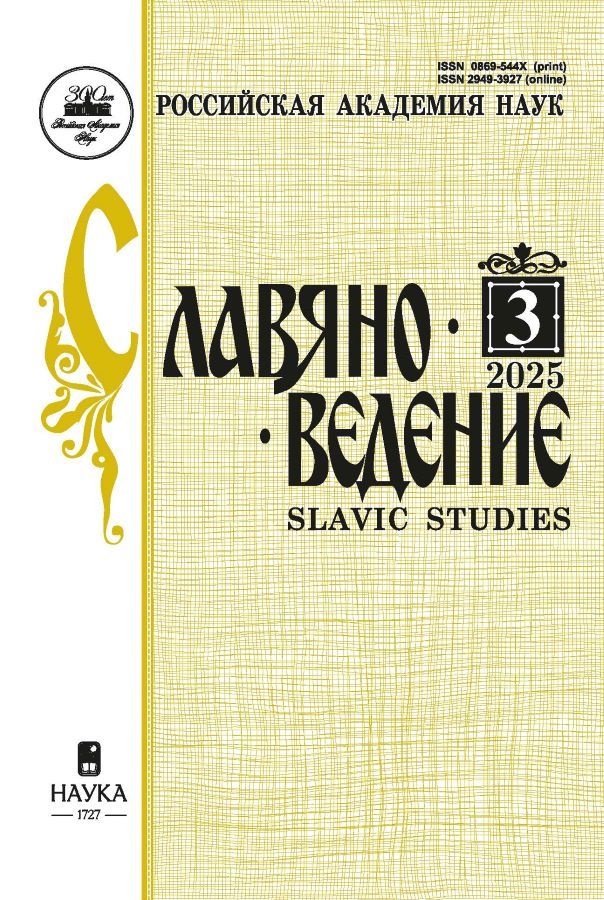Typology and lexicography: the russian verb brosit’ and its serbian translational equivalent baciti on a typological background
- Authors: Ryzhova D.A.1
-
Affiliations:
- HSE University
- Issue: No 2 (2024)
- Pages: 92-104
- Section: Articles
- URL: https://rjmseer.com/0869-544X/article/view/673320
- DOI: https://doi.org/10.31857/S0869544X24020082
- EDN: https://elibrary.ru/zdkiay
- ID: 673320
Cite item
Abstract
The paper presents the research conducted for the project “Comparative lexicology of the Serbian and Russian languages”, one of the key tasks of which is the development of a theoretical and methodological basis for a new Serbian-Russian dictionary. Using the example of two translational equivalents – Russian brosit’ and Serbian baciti – the paper examines the role of an accessible lexical typological background in a comparative analysis of semantics and distribution of words from closely related languages. We show that basic knowledge about the principles of lexicalization of the semantic field of throwing in the languages of the world makes it possible to identify subtle differences in the use of translational equivalents, such as a stronger deviation from the prototypical throwing for Russian brosit’ in comparison to Serbian baciti and differences between Russian and Serbian constructions with the meaning of throwing to a target. We believe that systematic account of typological patterns would be useful for compiling lexicographic descriptions of other semantic domains as well.
Full Text
About the authors
Daria A. Ryzhova
HSE University
Author for correspondence.
Email: daria.ryzhova@mail.ru
ORCID iD: 0000-0002-8387-0049
PhD (Philology), Associate Professor
Russian Federation, MoscowReferences
- Bagirokova I., Ryzhova D., Blinova A. Describing lexicon of an individual language on a typological background: The semantic field of throwing in West Circassian and beyond. Studies in Language, Under review.
- Egorova М. А. On the semantics and discourse functions of the aorist and the pluperfect in Modern Serbian: A study of Milorad Pavić’s novel The Inner Side of the Wind. Voprosy Jazykoznanija, 2022, iss. 3, pp. 14– 53. (In Russ.)
- Goddard C., Wierzbicka A. (eds.). Semantic and lexical universals: Theory and empirical findings, Amsterdam, John Benjamins Publishing Company Publ., 1994, 522 p.
- Haspelmath M. Comparative concepts and descriptive categories in crosslinguistic studies. Language, 2010, iss. 3 (86), pp. 663–687.
- Ivtushok E. Glagoly tipa «brosat’» v leksiko-tipologicheskom osveshchenii, eds. E. Lyutikova, A. Zimmerling, M. Konoshenko. Tipologiia morfosintaksicheskikh parametrov. Conference Proceedings, Moscow, MPSU Publ., 2015, pp. 114–122. (In Russ.)
- Ivtushok E. K tipologii glagolov so znachenijem «brosat’», ed. A. A. Kretov. Problemy leksiko-semanticheskoi tipologii, vol. 3, Voronezh, VSU Publ., 2016, pp. 72–77. (In Russ.)
- Kashkin E. Iazykovaia kategorizatsiia faktury poverkhnostei (tipologicheskoje issledovanije naimenovanii kachestvennykh priznakov v ural’skikh iazykakh). Diss. kand. filol. nauk. MSU, Moscow, 2013. (In Russ.)
- Kopecka A., Narasimhan B. (eds.). Events of putting and taking: A crosslinguistic perspective, Amsterdam, John Benjamins Publishing Company Publ., 2012, 389 p.
- Koptjevskaja-Tamm M. Talking temperature with close relatives: Semantic systems across Slavic languages, ed. by E. Rakhilina, T. Reznikova, D. Ryzhova. The typology of physical qualities, Amsterdam, John Benjamins Publishing Company Publ., 2022, pp. 215–268.
- Maisak T., Rakhilina E. (eds.) Glagoly dvizheniia v vode: leksicheskaia tipologiia. Moscow, Indrik Publ., 2007, 752 p. (In Russ.)
- Majid A. A guide to stimulus-based elicitation for semantic categories, ed. by N. Thieberger. The Oxford handbook of linguistic fieldwork, Oxford, Oxford University Press Publ., 2011, pp. 54–71.
- Majid A. Comparing lexicons cross-linguistically, ed. by J. R. Taylor. The Oxford handbook of the word, Oxford, Oxford University Press Publ., 2015, pp. 364–379.
- Majid A., Bowerman M. (eds.). Cutting and breaking events: A crosslinguistic perspective. Cognitive Linguistics, iss. 18 (2) [Special issue], 2007.
- Majid A., Jordan F., Dunn M. Semantic systems in closely related languages. Language Sciences, 2015, (49), pp. 1–18.
- Margetts A. et al. Cross-linguistic patterns in the lexicalisation of bring and take. Studies in Language, 2022, iss. 4 (46), pp. 934–993.
- Newman J. The linguistics of eating and drinking, Amsterdam, John Benjamins Publishing Publ., 2009, 298 p.
- Östling R. Studying colexification through massively parallel corpora, ed. by P. Juvonen, M. Koptjevskaja-Tamm. The lexical typology of semantic shifts, Berlin; Boston, Walter de Gruyter Publ., 2016, pp. 157–176.
- Plungian V. Vvedenije v grammaticheskuiu semantiku. Grammaticheskije znacheniia i grammaticheskije sistemy iazykov mira. Moscow, RSUH Publ., 2011, 672 p. (In Russ.)
- Podgornaya A. Glagoly brosaniia v cheshskom iazyke: leksiko-tipologicheskoje issledovanije. Kursovaia rabota. MSU, Moscow, 2021. (In Russ.)
- Rakhilina E., Reznikova T. Freimovyi podkhod k leksicheskoi tipologii. Voprosy iazykoznaniia, 2013, iss. 2, pp. 3–31. (In Russ.)
- Rakhilina E., Reznikova T., Ryzhova D. (eds.). Tipologiia glagolov padeniia, eds. E. Rakhilina, T. Reznikova, D. Ryzhova. Acta Linguistica Petropolitana. [Special issue], 2020, iss. 16 (1). (In Russ.)
- Rzymski C. et al. The Database of Cross-Linguistic Colexifications, reproducible analysis of cross-linguistic polysemies. Scientific Data, 2020, iss. 1 (7), p. 13.
- Wälchli B., Cysouw M. Lexical typology through similarity semantics: Toward a semantic map of motion verbs, Linguistics, 2012, iss. 3 (50), pp. 671–710.
- Wierzbicka A. Iazyk. Kul’tura. Poznanije. Moscow, Russkije slovari Publ., 1996, 412 p. (In Russ.)
- Zalizniak A. et al. The catalogue of semantic shifts as a database for lexical semantic typology. New directions in lexical typology, [Special issue], Linguistics, 2012, iss. 3 (50), pp. 633–669.
- Zalizniak A. The Catalogue of Semantic Shifts: 20 Years Later. Russian Journal of Linguistics, 2018, iss. (22), pp. 770–787.
Supplementary files














